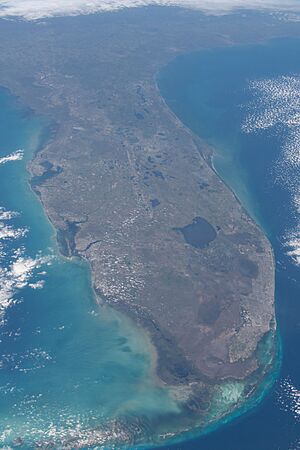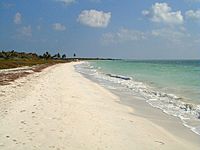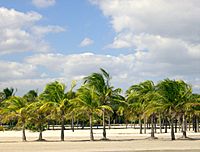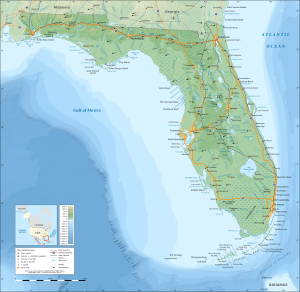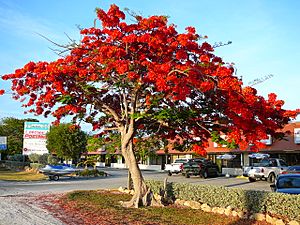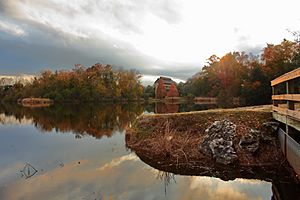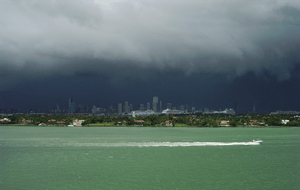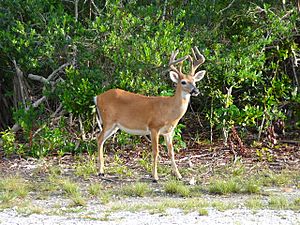Geography of Florida facts for kids
Florida is a large state in the southeastern United States. It's mostly a peninsula, a piece of land surrounded by water on three sides. Florida sits between the Gulf of Mexico, the Atlantic Ocean, and the Straits of Florida. It also has a "panhandle" part that stretches northwest along the Gulf.
Florida shares its northern border with Georgia and Alabama. It's also close to the Bahamas and countries like Cuba. Florida is one of the biggest states east of the Mississippi River. Only Alaska and Michigan have more water area.
Contents
Florida's Landscape
Florida has three main types of land areas: the Gulf Coastal Lowlands, the Atlantic Coastal Lowlands, and the Interior Highlands. The coastal lowlands are flat areas along the shoreline, stretching about 30 to 50 miles (48 to 80 km) inland. They then blend into the Interior Highlands.
Land Features
The highest point in Florida is Britton Hill, which is only 345 feet (105 meters) above sea level. This makes it the lowest high point of any U.S. state! Much of Florida, especially south of Orlando, is very flat and low. However, some places like Clearwater have small hills that rise 50 to 100 feet (15 to 30 meters) above the water.
Central and North Florida, away from the coast, have rolling hills that are usually 100 to 250 feet (30 to 76 meters) high. A special land feature in peninsular Florida is the Lake Wales Ridge. This is a narrow sandy ridge that runs north to south. The highest point on this ridge is Sugarloaf Mountain, which is 312 feet (95 meters) tall.
Many parts of Florida, including cities like Miami, are less than 12 feet (3.7 meters) above sea level. This makes them very open to rising sea levels caused by climate change. Because Florida sits on a lot of limestone, water can move easily underground and rise to the surface. Rising water could also come from the Atlantic Coast and the Gulf Coast, and through the Everglades, which would harm the plants there.
A study in 2014 found that Florida is the flattest state in the U.S.
State Borders
Florida's border starts in the Atlantic Ocean. It then goes west, south, and north along the middle of the Saint Mary's River. Where that river begins, the border goes almost straight west and slightly north. This point used to be where the Flint River and the Chattahoochee River joined to form Florida's Apalachicola River. Now, this spot is under Lake Seminole because of the Woodruff Dam.
The border with Georgia continues north through the lake for a short distance along the old path of the Chattahoochee River. Then, the border with Alabama runs straight west along the 31st parallel north to the Perdido River. From there, it goes south along the middle of that river to the Gulf of Mexico through Perdido Bay.
Florida's Geology
The Florida peninsula is a plateau made of karst limestone. This limestone is very porous, meaning it has many holes, and it sits on a base rock called the Florida Platform. This land formed millions of years ago. The first land animals appeared in Florida during the Miocene period.
Florida has the largest deposits of phosphate rock in the country.
Many underwater caves, sinkholes, and springs are found all over the state. These supply most of the water that people use. The limestone is covered with sandy soils. These sands were left behind by ancient beaches over millions of years as global sea levels went up and down. During the last ice age, sea levels were lower, and Florida was much wider and covered in savanna. The Everglades is a very wide, slow-moving river that covers the southern tip of the peninsula.
While sinkholes can happen anywhere in the state, most recent ones have been in West-Central Florida.
Florida is tied with North Dakota for having the fewest earthquakes of any U.S. state. Earthquakes are very rare because Florida is not near any tectonic plate boundaries. However, they are not completely unknown. For example, in January 1879, an earthquake near St. Augustine caused plaster to fall from walls. In 1880, strong earthquakes in Cuba sent shock waves through Key West. The 1886 Charleston earthquake was also felt across northern Florida. More recently, in 2006, a magnitude 6.0 earthquake in the Gulf of Mexico sent shock waves through southwest and central Florida, but it caused no damage.
Florida's Climate

Florida's climate is mild because no part of the state is very far from the ocean. North of Lake Okeechobee, the climate is humid subtropical. This means it has hot, humid summers and mild winters. Coastal areas south of the lake, including the Florida Keys, have a true tropical climate, which is warm all year round.
In late July, high temperatures are usually in the low 90s Fahrenheit (32–34 °C). In early to mid-January, low temperatures range from the low 40s Fahrenheit (4–7 °C) in northern Florida to the mid-50s (around 13 °C) in southern Florida.
In summer, temperatures rarely go above 100 °F (38 °C). In late autumn and winter, cold fronts can bring strong winds and cooler temperatures. Highs might stay in the 40s and 50s (4 to 15 °C), with lows in the 20s and 30s (−7 to 4 °C). These cold spells usually last only a few days in northern and central Florida. Southern Florida rarely gets temperatures below freezing.
The hottest temperature ever recorded in Florida was 109 °F (43 °C) on June 29, 1931, in Monticello. The coldest was −2 °F (−19 °C) on February 13, 1899, in Tallahassee.
Florida's seasons are more about how much rain falls than about temperature. The hot, wet springs and summers are the wet season. The mild to cool, dry winters and autumns are the dry season. Fall foliage (leaves changing color) appears in Central and North Florida around late November and into winter. During El Niño years, there is more rainfall between November and March. After an El Niño in 1998, there were 480 wildfires.
The Florida Keys have more stable temperatures because they are surrounded by water. In Key West, temperatures rarely go above 95 °F (35 °C) in summer or below 55 °F (13 °C) in winter. Frost has never been reported in the Keys.
| Average high and low temperatures for various Florida cities (°F) | ||||||||||||
| City | Jan | Feb | Mar | Apr | May | Jun | Jul | Aug | Sep | Oct | Nov | Dec |
| Jacksonville | 65/43 | 68/45 | 74/50 | 80/56 | 86/64 | 90/70 | 92/73 | 91/73 | 87/70 | 80/61 | 73/51 | 66/44 |
| Key West | 75/65 | 76/66 | 79/69 | 82/72 | 85/76 | 88/78 | 89/80 | 90/80 | 88/78 | 85/76 | 80/71 | 76/67 |
| Melbourne | 72/51 | 73/53 | 77/57 | 81/61 | 85/67 | 88/71 | 90/73 | 90/73 | 88/72 | 83/67 | 78/60 | 73/53 |
| Miami | 76/60 | 77/61 | 80/64 | 83/68 | 86/72 | 88/75 | 90/77 | 90/77 | 88/76 | 85/72 | 81/67 | 77/62 |
| Orlando | 72/50 | 75/52 | 79/56 | 84/61 | 88/66 | 91/72 | 92/73 | 92/74 | 90/72 | 85/66 | 78/58 | 74/53 |
| Pensacola | 61/43 | 64/46 | 70/51 | 76/58 | 84/66 | 89/72 | 90/74 | 90/74 | 87/70 | 80/60 | 70/50 | 63/45 |
| Tallahassee | 64/40 | 67/42 | 73/48 | 80/53 | 87/62 | 91/69 | 91/72 | 91/72 | 88/68 | 81/57 | 72/47 | 66/41 |
| Tampa | 71/51 | 72/52 | 77/57 | 82/62 | 88/68 | 90/73 | 90/75 | 90/75 | 89/73 | 84/66 | 77/58 | 72/52 |
Severe Weather in Florida
Florida is known as the "Sunshine State," but it also gets a lot of severe weather. Central Florida is called the "lightning capital" of the United States because it has more lightning strikes than anywhere else.
Florida gets the most rain of any state. This is largely because afternoon thunderstorms are common from late spring to early autumn. A sunny day can quickly turn into a storm, only to become sunny again an hour later. These storms happen when moist air from the Gulf of Mexico and Atlantic Ocean meet. They can bring heavy rain, strong winds, and sometimes tornadoes. Florida has the most tornadoes per square mile (including waterspouts), but they are usually not as strong as those in the Midwest. Hail sometimes falls during the worst thunderstorms.
A narrow strip on the eastern side of the state, including Orlando and Jacksonville, gets about 2,400 to 2,800 hours of sunshine each year. The rest of the state, like Miami, gets even more, between 2,800 and 3,200 hours annually.

Snow is very rare in Florida, especially on the peninsula. During the Great Blizzard of 1899, Florida had blizzard conditions. The Tampa Bay area even saw "gulf-effect" snow, similar to how "lake-effect snow" happens near the Great Lakes. The 1899 blizzard was the only time the temperature in Florida is known to have dropped below 0 °F (−18 °C).
The most widespread snowfall in Florida happened on January 19, 1977. Snow fell over much of the state, with light snow as far south as Homestead. Snow also fell on Miami Beach for the only time in recorded history. In 2003, a very cold spell brought "ocean-effect" snow to the Atlantic coast as far south as Cape Canaveral.
The 1993 Superstorm brought blizzard conditions to the panhandle. The peninsula experienced heavy rain and tornadoes. This storm was similar to a hurricane, with some Gulf coast areas seeing storm surges of six feet (1.8 meters) or more. In January 2010, traces of snow and sleet fell across central Florida during another cold event.
Hurricanes in Florida
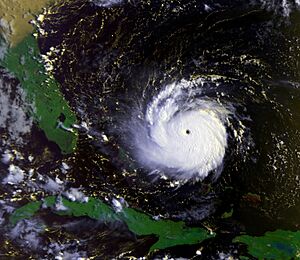
Hurricanes are a serious threat during hurricane season, which runs from June 1 to November 30. Florida is the most hurricane-prone U.S. state because it has a long coastline surrounded by warm water. From 1851 to 2006, Florida was hit by 114 hurricanes. Thirty-seven of these were major hurricanes (Category 3 and above). It's rare for a hurricane season to pass without at least a tropical storm affecting Florida. For Category 4 or higher storms, 83% have hit either Florida or Texas. August to October is the most likely time for a hurricane in Florida.
In 2004, Florida was hit by a record four hurricanes: Hurricane Charley (August 13), Hurricane Frances (September 4–5), Hurricane Ivan (September 16), and Hurricane Jeanne (September 25–26). These storms together cost the state's economy $42 billion. In 2005, Hurricane Dennis (July 10) was the fifth storm to hit Florida in eleven months. Later, Hurricane Katrina (August 25) passed through South Florida, and Hurricane Rita (September 20) swept through the Florida Keys. Hurricane Wilma (October 24) hit near Marco Island, ending another very active hurricane season. Wilma is the second most expensive hurricane in Florida's history.
Florida was also the site of the second costliest weather disaster in U.S. history, Hurricane Andrew. It caused over $25 billion in damage when it hit on August 24, 1992. Other famous hurricanes include the 1926 Miami hurricane, the 1928 Okeechobee hurricane, the Labor Day Hurricane of 1935, Hurricane Donna in 1960, Hurricane Opal in 1995, and Hurricane Michael in 2018.
Florida's Wildlife
Florida is home to many different types of animals, including:
Marine Mammals
The waters off Florida and Georgia are the only known place where the northern right whale gives birth.
Reptiles in Florida
- American alligator and crocodile
- eastern diamondback and pygmy rattlesnakes
- gopher tortoise
- green and leatherback sea turtles
- eastern indigo snake
A number of non-native snakes have been released into the wild in Florida. In 2010, the state started a hunting season for Burmese and Indian pythons, African rock pythons, green anacondas, and Nile monitor lizards to control their populations.
Mammals in Florida
- Florida panther
- northern river otter
- mink
- eastern cottontail rabbit
- marsh rabbit
- raccoon
- striped skunk
- squirrel
- white-tailed deer
- Key deer
- bobcats
- gray fox
- coyote
- wild boar
- Florida black bear
- nine-banded armadillos
Birds in Florida
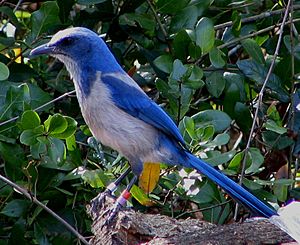
- bald eagle
- crested caracara
- snail kite
- osprey
- white and brown pelicans
- sea gulls
- whooping and sandhill cranes
- roseate spoonbill
- Florida scrub jay (found only in Florida)
One type of wild turkey, called Meleagris gallopavo osceola, is found only in Florida. The state is also a winter home for many bird species from eastern North America.
Invertebrates in Florida
- carpenter ants
- termites
- American cockroach
Since they were accidentally brought to North America from South America in the 1930s, red imported fire ants have spread across most of the Southern United States, including Florida. They are more aggressive than most native ants and have a painful sting.


